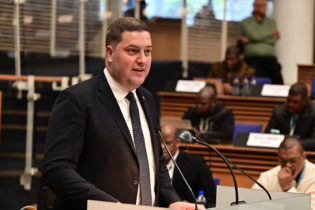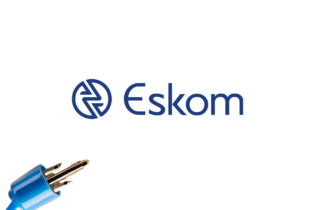The South African Institution of Civil Engineering (SAICE) launched its much-anticipated 2022 Infrastructure Report Card (IRC) on Friday, 11 November. It reflects an expert view of the institution’s reporting on the current condition of a broad range of public infrastructure.
The 2022 IRC is the fourth report released by the SAICE and rates the overall condition of South Africa’s infrastructure as a D, the lowest rating since the first IRC launched in 2006.
2023 SAICE President-Elect,
Steven Kaplan, explains that the overall goal of the IRC is to increase awareness and influence change for the better. “We aim to also stimulate debate on the condition of South Africa’s infrastructure and its effect on the quality of life and the economy.”
The IRC team, led by Convenor
Sam Amod and Research Leader
Dr Kevin Wall, analysed large volumes of detailed information, and followed a rigorous process in preparing the IRC. However, being a condition and performance assessment, the IRC does not prescribe remedies to the findings.
Both Amod and Dr. Wall explain that in each IRC, SAICE has progressively widened the scope of its scrutiny. “In this report we introduce fire engineering, information and communication technology (ICT), oil and gas pipelines, and coastal infrastructure, and reintroduce fishing harbours to the portfolio. Our comments also touch upon the impact of global warming and other environmental factors on infrastructure.”
The Scorecard in Summary
The scorecard is based on a simple five-point scale – A (world-class), B (fit for the future), C (satisfactory for now), D (at risk of failure), and E (unfit-for-purpose) and features a snapshot of the current condition and performance of 32 subsectors of infrastructure. These include gradings for:
Water: The quality and reliability of water supply has decreased in small towns and rural systems. In contrast, the national water resources infrastructure system has been able to meet the demands for which it was designed.
- Bulk water resources: D-
- Major urban areas: C+
- All other areas: D-
Sanitation: (including wastewater) – 16% of households still need improved sanitation.
- Major urban areas: C-
- All other areas: E
Solid waste management: A slight reduction in the provision of refuse removal services in urban areas. In rural areas, there is a significant increase in indiscriminate dumping.
- Waste collection in the major urban areas: C-
- Waste collection in other areas: D-
- Waste disposal in metros: C-
- Waste disposal in other areas: D-
Roads: The consequences of the widespread underfunding of road maintenance and improvement is cause for great concern.
- National roads: B+
- Paved provincial roads: D
- Paved roads in the major urban areas: D
- Other municipalities’ paved roads: D-
- Provincial and municipal unpaved roads: E
Airports: The impact of Covid-19 on ACSA and aviation has been severe, leading to significant financial and human resource losses. While aircraft and passenger safety were not compromised during this time, renewal and maintenance were.
- ACSA-owned facilities: B-
Ports: Well-developed standards and regulations govern infrastructure condition assessments and the maintenance, repair, and rehabilitation system.
- Commercial ports: B-
- Fishing harbours: B
Oil and gas pipelines: B – The pipelines are inspected and maintained as rigorously as their location permits.
Rail: Safety and security have deteriorated quickly, and fewer trains are dispatched yearly due to infrastructure, process, and systems issues.
- Heavy haul freight lines: B-
- General freight lines: C-
- Branch lines: E
- PRASA passenger lines: E
- Gautrain: A-
Electricity: Peak demand for Eskom electricity has declined slowly over the last 10 years. It reflects the increasing unreliability of supply, increasing tariffs, and the increasing availability of alternative sources of electricity.
- Eskom generating infrastructure: D-
- Eskom transmission network: B
- Local distribution: D
Healthcare: The Ideal Clinic Programme has yielded positive results in some provinces over the past few years.
Fire: (no grading available) Municipal fire protection services are inadequate, and public sector buildings are not compliant with fire safety regulations.
Education: Dramatically increased student intakes have placed a severe burden on infrastructure. Also, considerable damage is caused by vandalism and student protests.
- Public ordinary schools: D
- Universities: C+
- TVET colleges: D+
Information and communication technology: B Although the general condition of physical ICT infrastructure in South Africa is good, theft and/or vandalism is cause for concern.
The overall grade of South Africa’s public infrastructure:
Factors influencing the gradings include crime and non-payment for services, inadequate infrastructure management and maintenance, and weak institutions lacking appropriate skills and accurate data contribute towards a further decline in the overall infrastructure condition since the last IRC.
However the report indicates that there are reasons for optimism as many managers, professionals and skilled and unskilled workers persevere in their tasks to improve things. While increased access to improved sanitation, drinking water, electricity, and transport have increased. It has placed these systems under immense pressure.
SAICE President
Professor Marianne Vanderschuren adds: “We strive to enable our members and the greater engineering industry to provide society with environmentally and economically sustainable infrastructure. We believe that the IRC is the most effective tool the institution possesses to uphold and advance the professional ethics of the civil engineering profession.”
She says the institution will avail itself to the government and the public to discuss the findings in the IRC4 and engage developing the best solutions to help South Africa grow forward.
Amod and Dr. Wall also express their hope that the IRC report will inform and influence all South Africans about the importance of protecting and enhancing the physical infrastructure that is so critical to daily existence and our common prosperity. “We hope that it contributes to the improved use of infrastructure funding, especially for preventative maintenance. We expect that it will stimulate debate on the matters raised herein by the professionals who grapple daily with meeting the infrastructure needs of a nation.”
To access the full 2022 Infrastructure Report Card, visit: www.saice.org.za/irc








